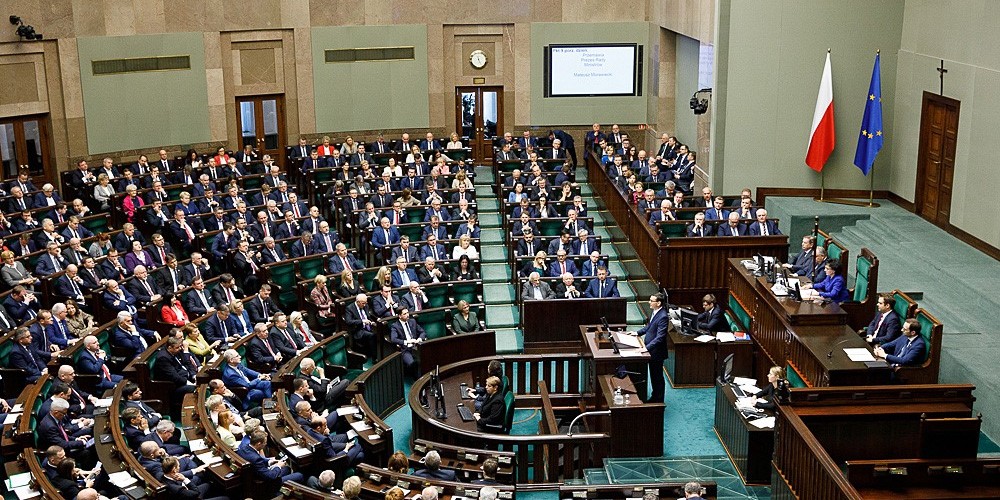Author: webadmin
Why are there fewer women than men in politics?

All over the world, there are far fewer women than men in political positions, and the disproportion is particularly visible in the case of senior positions. In Poland, in the initial years of transition, the participation of women in politics was very limited, and for many years Poland has performed quite poorly in the ranking of European countries based on general equality indicators, and in particular the position of women in politics. In 2011, the Polish government took steps to reduce the disproportion in women’s political participation by introducing proportional quotas on electoral lists. However, despite the increase in the proportion of female candidates on these lists and despite the increase in the number of female deputies in the Sejm, the number of women in Parliament still remains significantly lower than the number of men. In part, this is probably due to the conservative views or even prejudices of voters themselves. However, a significant role is also played by prejudices within political parties, whose leaders do not place women in top positions on electoral lists. It seems, therefore, that the introduction of gender quotas alone is not enough to overcome the barriers faced by women in the electoral process and further, more comprehensive changes in the law may be necessary.
The full Report is available here.
Reports from Belarus, Georgia, Latvia, Ukraine and Russia are available in English and the national languages here.
Transition and beyond: women on the labour market in the context of changing social norms

As countries brace themselves for a severe economic slowdown in response to the COVID-19 pandemic, earlier crises, such as that which followed the political transformation of Central and Eastern Europe and the former Soviet Union in the 1990s, may serve as important points of reference. While of course different in many ways, the changes that accompanied the transition affected society as a whole, but also had heterogenous effects across different groups. One particular dimension – also discussed in relation to the current COVID-19 crises – is that of relative costs and benefits for men and women respectively. In this brief we re-examine one specific element of this, namely the developments of gender gaps in the labour market and social norms related to labour market activity over time and across countries, starting in the years before transition.
Similarly to the current economic crisis related to the COVID-19 pandemic, the socio-economic developments of the post-transition period left women in Poland in a less favourable economic position relative to men. Here we discuss two main sources of gender inequalities in the context of the Polish labour market – the gender gap in employment and pay. Though a certain improvement in this regard can be observed over the last 30 years, significant inequalities between women and men remain today and may have substantial impact in the future, especially for differences in poverty risk in old age.
CenEA is a partner in DIAGNOZA.plus, a study of the Polish labour market

The University of Warsaw in cooperation with GRAPE, CASE, CenEA and IBS is carrying out a study of the Polish labour market DIAGNOZA.plus.
The project focuses on the analysis of current labor market indicators such as the unemployment and employment rates, the wage level and working conditions.
This innovative study carried out in the form of online interviews facilitates amon other things the analysis of how the COVID-19 pandemic and the economic slow-down it caused has affected the Polish labor market.
Information about the study and current reports prepared on the basis of its results can be found at DIAGNOZA.plus.
Kwota wolna od podatku i zerowy PIT w końcówce prezydenckiej kampanii wyborczej 2020

Podczas kampanii przed wyborami na urząd Prezydenta RP w 2020 r. pojawił się szereg deklaracji dotyczących zmian systemu opodatkowania dochodów. Częstym punktem odniesienia w prowadzonej debacie była obietnica starającego się o reelekcję Prezydenta Andrzeja Dudy, dotycząca podniesienia kwoty wolnej od podatku do 8 000 zł rocznie dla wszystkich podatników rozliczających się według skali, która stanowiła jego sztandarowe hasło wyborcze w poprzedniej kampanii prezydenckiej w 2015 r. W Komentarzu przedstawiono analizy porównujące tę deklarację do propozycji podatkowej kontrkandydata urzędującego Prezydenta, Prezydenta Warszawy Rafała Trzaskowskiego. Według tej propozycji podatnicy o dochodach do 30 tys. zł brutto rocznie byliby zwolnieni z podatku PIT, osoby zarabiające 30 – 65 tys. zł brutto korzystałyby z kwoty wolnej od podatku na poziomie 8 000 złotych rocznie, zaś dla pozostałych podatników obecne zasady opodatkowania nie uległyby zmianie.
Konkurs na stypendium naukowe dla Doktoranta/ki w projekcie badawczym

Poszukujemy Doktoranta/Doktorantki do współpracy w projekcie badawczym “Material Conditions and Older Age Wellbeing in Germany and Poland: Institutional and Regional Variation in Individual Risks and Insurance Mechanisms”.
Zadania:
- udział w realizacji zadań badawczych w ramach projektu
- przegląd i opis anglojęzycznych pozycji z literatury przedmiotu z zakresu projektu
- aktywne uczestnictwo w krajowych i międzynarodowych konferencjach naukowych
- przejęcie odpowiedzialności za część badań w projekcie, która zostanie wykorzystana w pracy doktorskiej Doktoranta
Wymagania:
- status doktoranta(ki) lub oświadczeniu o przystąpieniu/zamiarze przystąpienia do rekrutacji do szkoły doktorskiej na rok akademicki 2020/2021
- bardzo dobra znajomość języka angielskiego
- wiedza z zakresu metod ilościowych, mile widziana znajomość pakietów statystycznych Stata, R lub podobnych
- zainteresowanie zastosowaniem metod ilościowych w naukach ekonomicznych
- mile widziane doświadczenie w prowadzeniu badań naukowych, zakończonych publikacjami
CV wraz z listą publikacji i działalności naukowej oraz dodatkowe dokumenty należy przesłać na adres admin@cenea.org.pl. Termin składania ofert: 13.09.2020 r.
Szczegóły konkursu, warunki zatrudnienia i wymagane dokumenty znajdują się w załączonym ogłoszeniu.
Ogłoszenie zostało również opublikowane na stronie Narodowego Centrum Nauki.
***
Wyniki konkursu
W odpowiedzi na ogłoszenie o konkursie na stanowisko doktoranta – stypendysty w CenEA w projekcie badawczym Beethoven „Material Conditions and Older Age Wellbeing in Germany and Poland: Institutional and Regional Variation in Individual Risks and Insurance Mechanisms” w terminie zakreślonym w ogłoszeniu otrzymano jedno zgłoszenie. Po analizie przesłanych dokumentów i rozmowie kwalifikacyjnej z kandydatem, mgr Ellamem Kulati, w dniu 16.09.2020 r. komisja stypendialna pod przewodnictwem dr hab. Michała Mycka podjęła decyzję o przyjęciu kandydata na stanowisko stypendysty. Zgodnie z warunkami ogłoszenia stypendium jest uwarunkowane zapewnieniem przez kandydata miejsca w szkole doktorskiej w Polsce w bieżącym roku akademickim.
Kwota wolna od podatku i świadczenie wychowawcze 500+ po pięciu latach od prezydenckich deklaracji

W czasie kampanii prezydenckiej w 2015 roku jednymi z głównych haseł wyborczych Prezydenta Andrzeja Dudy były dwa rozwiązania w systemie podatkowo-świadczeniowym – wprowadzenie świadczenia dla rodzin z dziećmi w wysokości 500 złotych miesięcznie i uniwersalne podniesienie wysokości kwoty wolnej od podatku do 8 000 zł. W niniejszym Komentarzu przedstawiono analizy skupiające się na tych dwóch elementach systemu podatkowo-świadczeniowego, a przyjęte ostatecznie przez rząd i Parlament rozwiązania w tych kwestiach porównano do deklaracji składanych przez Andrzeja Dudę przed wyborami prezydenckimi, a następnie powtórzonych w czasie kampanii wyborczej do Parlamentu w 2015 roku w programie Prawa i Sprawiedliwości.
Dane do wykresów przedstawionych w Komentarzu są dostępne tutaj.
Kontakt dla mediów:
dr. hab. Michał Myck, mmyck@cenea.org.pl, tel. 91 831 40 29
Ahead of Future Waves of Covid-19: A Regional Perspective on Health Risks and Healthcare Resources in Germany and Poland

Drawing on the most fundamental conclusions from the early research on the Covid-19 pandemic, in this policy paper we examine the regional prevalence of a number of risk factors related to severe consequences of Covid-19. Using the examples of Germany and Poland, two neighbouring countries which have generally dealt relatively well with the outbreak in recent months, we show that there is significant regional variation both in the distribution of health status and healthcare resources. Highly differentiated demographic and epidemiological risks related to the pandemic between as well as within Germany and Poland call for a decentralised evaluation of risks and point out the need to consider an application of regionally focused policy reactions such as lockdowns and social distancing regulations. The cross-country regional perspective adds a valuable angle to the analysis of challenges raised by the Covid-19 pandemic and should urgently be considered regarding any possible consequences of future outbreaks of the virus.
Safety of older people during the COVID-19 pandemic: coresidence of people aged 65+ in Poland compared to other European countries

Due to the fact that both the risk of severe symptoms from the disease and the risk of death as a result of complications after coronavirus infection significantly increases with the age of the infected person, the most vulnerable group is the elderly. In this report, we present an analysis of the housing situation of people aged 65+ in Poland compared to other European countries, with our results indicating that there is a large diversity in health risks for the elderly. This is due, on the one hand, to differences in the rate of cohabitation with younger people, and on the other, to differences in the frequency of using care institutions in later life. One of the basic challenges for both health and socio-economic policy design in the coming months will be to ensure safety and reduce coronavirus infection in the oldest population group. Decisions regarding the loosening of regulations that have imposed an obligation to maintain social distancing, in addition to considering incidence statistics, should also take these differences into account.
The Commentary Paper is available here.
The results presented in the paper are also available in Microsoft Excel.
COVID19 | FREE Network Project

The Covid-19 pandemic is affecting all the inhabited continents of this planet and leaves none of us untouched. It has already killed thousands of people across the globe, closed down cities, borders and businesses and most countries are still just in the initial phase of this crisis. Although there is 24/7 reporting on the pandemic, much of the focus in international media has been on the most affected countries and richer countries in Eastern Asia, the EU and the US. Much less attention has been given to countries around the Baltics, in Eastern Europe and the Caucasus.
However, these countries are home to more than 200 million people and to the institutes that form the Forum for Research on Eastern Europe and Emerging Economies, i.e. the FREE network. The FREE Network has therefore started to collect data on this region from official sources with the ambition to offer a regularly updated, comprehensive and easily comparable overview of the health impact of the Covid-19 pandemics, as well as the policies and practices countries in the region adopt to deal with it.
The countries in the network and the region that are included in the project are Belarus, Georgia, Latvia, Poland, Russia, Sweden, and Ukraine. Italy is included as a point of comparison since it is a country that has been particularly badly affected and several people involved in the project know Italian and follow these developments closely. In addition to FREE Network countries, Armenia, Estonia, Lithuania, Moldova and Germany are covered due to close links between the network and economists and researchers specialised in these countries, therefore extending the covered region.
The COVID19 FREE Network Project covering the above mentioned countries is available here.
The Poland country report is available here.
School lockdown: distance learning environment during the COVID-19 outbreak

In connection with the coronavirus COVID-19 outbreak, Poland’s Minister of Education, in a Regulation introduced on the 20th March 2020, postponed the end date of the lockdown of Polish schools until the 10th April 2020. Since the 25th March 2020, 4.6M students in Poland have been studying remotely, and any decisions on reopening schools or extending the lockdown depend on the course of development of the pandemic. Even at the time of “regular” access to schooling, the discrepancies in living conditions between students, in particular in terms of their housing conditions and household infrastructure, have a substantial impact on the overall quality of learning and educational outcomes, all the more so when students have to switch to distance learning. In the current situation, substandard housing conditions and lack of access to a computer or the Internet can make it difficult or outright impossible for many students to access education in the coming weeks.
The full report is available here.
The results presented in the report are also available in Microsoft Excel.


